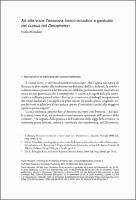Chapter Ad alta voce: l’essenza fonico-acustica e gestuale del cursus nel Decameron
| dc.contributor.author | Mondani, Paola | |
| dc.date.accessioned | 2022-06-01T12:15:39Z | |
| dc.date.available | 2022-06-01T12:15:39Z | |
| dc.date.issued | 2020 | |
| dc.identifier | ONIX_20220601_9788855182362_360 | |
| dc.identifier.issn | 2704-5919 | |
| dc.identifier.uri | https://library.oapen.org/handle/20.500.12657/56177 | |
| dc.description.abstract | Moving from the studies carried out by Alfredo Schiaffini and Vittore Branca on Boccaccio’s reuse, in its prosaic masterpieces (the Filocolo, the Elegy of Madonna Fiammetta and the Decameron), of mediaeval rhetorical-rhythmics rules, the essay offers an analysis of cursus applied to Decameron, realized by separating the text into three parts: introductive-proemial section, narrative section and dialogue section. The rhetorical devices are more strictly employed both in the first part, when the author or the internal storytellers speak, and into speeches given by characters in the middle of the narration. This, according to the original function of Greek cursus, would suggest its use in Boccaccio’s prose as a mimetic device, that replicates the oratory declamation. | |
| dc.language | Italian | |
| dc.relation.ispartofseries | Studi e saggi | |
| dc.subject.other | Cursus | |
| dc.subject.other | Prose rhythm | |
| dc.subject.other | Rhetoric | |
| dc.subject.other | Boccaccio | |
| dc.subject.other | Decameron | |
| dc.title | Chapter Ad alta voce: l’essenza fonico-acustica e gestuale del cursus nel Decameron | |
| dc.type | chapter | |
| oapen.identifier.doi | 10.36253/978-88-5518-236-2.04 | |
| oapen.relation.isPublishedBy | bf65d21a-78e5-4ba2-983a-dbfa90962870 | |
| oapen.relation.isbn | 9788855182362 | |
| oapen.series.number | 219 | |
| oapen.pages | 24 | |
| oapen.place.publication | Florence |

